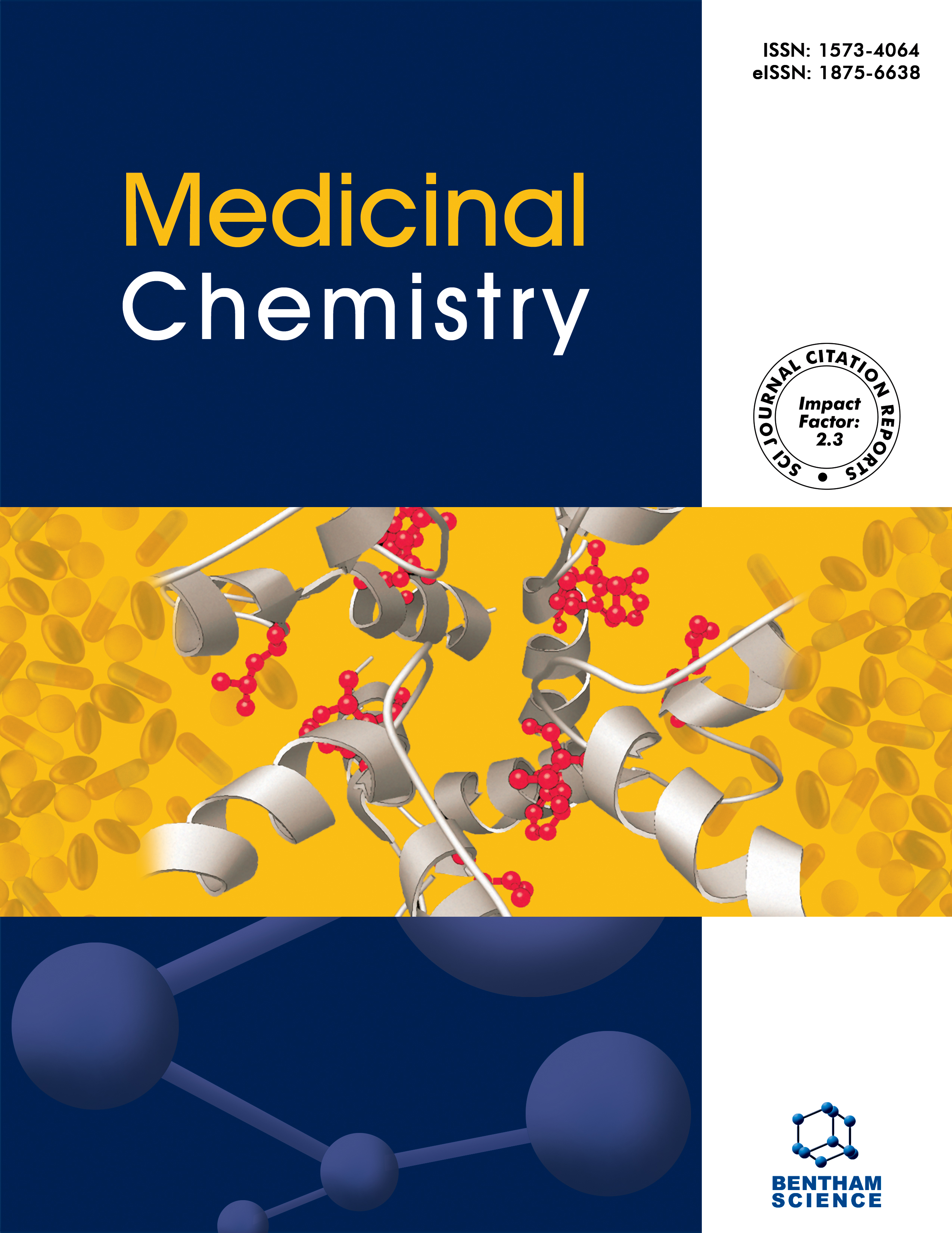- Home
- A-Z Publications
- Medicinal Chemistry
- Previous Issues
- Volume 15, Issue 1, 2019
Medicinal Chemistry - Volume 15, Issue 1, 2019
Volume 15, Issue 1, 2019
-
-
Sorbinil, an Aldose Reductase Inhibitor, in Fighting Against Diabetic Complications
More LessAuthors: Qi Huang, Qiong Liu and Dongsheng OuyangBackground: Aldose reductase (AR) is involved in the pathogenesis of diabetes, which is one of the major threats to global public health. Objective: In this review article, we have discussed the role of sorbinil, an AR inhibitor (ARI), in preventing diabetic complications. Results: AR contributes in diabetes by generating excess intracellular superoxide and other mediators of oxidative stress through polyol pathway. Inhibition of AR a Read More
-
-
-
Pyrano[3,2-c]quinoline Derivatives as New Class of α-glucosidase Inhibitors to Treat Type 2 Diabetes: Synthesis, in vitro Biological Evaluation and Kinetic Study
More LessBackground: Pyrano[3,2-c]quinoline derivatives 6a–n were synthesized via simple two-step reactions and evaluated for their in vitro α-glucosidase inhibitory activity. Methods: Pyrano[3,2-c]quinoline derivatives 6a–n derivatives were prepared from a two-step reaction: cycloaddition reaction between 1-naphthyl amine 1 and malonic acid 2 to obtain benzo[h]quinoline-2(1H)-one 3 and reaction of 3 with aryl aldehydes 4 and Mel Read More
-
-
-
Pyrazole and imidazo[1,2-b]pyrazole Derivatives as New Potential Anti-tuberculosis Agents
More LessBackground: We screened a large library of differently decorated imidazo-pyrazole and pyrazole derivatives as possible new antitubercular agents and this preliminary screening showed that many compounds are able to totally inhibit Mycobacterium growth (>90 %). Among the most active compounds, we selected some new possible hits based on their similarities and, at the same time, on their novelty with respect to the pi Read More
-
-
-
4-Hydroxy-2-pyridone Derivatives and the δ-pyrone Isostere as Novel Agents Against Mycobacterium smegmatis Biofilm Inhibitors
More LessBackground: The treatment of a bacterial infection when the bacterium is growing in a biofilm is a vexed issue. This is because the bacteria in a biofilm behaves differently compared to the individual planktonic free-form. As a result, traditional antibacterial agents lose their activity. Objective: Presently, there are not many drugs that are effective against bacteria growing in biofilms. Based on literature reports, we have sought Read More
-
-
-
Synthesis and Evaluation of the in vitro Antimicrobial Activity of Triazoles, Morpholines and Thiosemicarbazones
More LessBackground: Microbial infections is a global public health problem. The aim of this work was to synthesize and evaluate the antimicrobial activity of novel triazoles, morpholines and thiosemicarbazones. Methods: Compounds were synthesized using 2,4-Dihydroxyacetophenone and 4-hydroxybenzaldehyde as starting materials. The antimicrobial activity of these compounds against bacteria and yeast was evaluated by Read More
-
-
-
The Evaluation of Metal Co-ordinating Bis-Thiosemicarbazones as Potential Anti-malarial Agents
More LessBackground: The emergence of resistance to the artemisinins which are the current mainstays for antimalarial chemotheraphy has created an environment where the development of new drugs acting in a mechanistally discrete manner is a priority. Objective: The goal of this work was to synthesize ane evaluate bis-thiosemicarbazones as potential antimalarial agents. Methods: Fifteen compounds were generated using tw Read More
-
-
-
Design, Synthesis and Investigation of New Diphenyl Substituted Pyridazinone Derivatives as Both Cholinesterase and Aβ-Aggregation Inhibitors
More LessBackground: With respect to the increase in the average life expectancy, Alzheimer Disease (AD), the most common form of age-related dementia, has become a major threat to the population over the age of 65 during the past several decades. The majority of AD treatments are focused on cholinergic and amyloid hypotheses. Objective: In this study, three series of diphenyl-2-(2-(4-substitutedpiperazin-1-yl)ethyl)pyridazin- 3( Read More
-
-
-
Synthesis and Biological Evaluation of Novel 2,3-disubstituted Benzofuran Analogues of GABA as Neurotropic Agents
More LessBackground: Benzofurans are heterocyclic compounds with neurotropic activity. Some have been developed for the treatment of acute and degenerative neuronal injuries. Objective: The study aimed to evaluate the in silico binding of some promising benzofurans on the GABA receptors, and the in vivo neurotropic activity of benzofuran analogues (BZF 6-10) of gamma-aminobutyric acid (GABA) on a seizure model. Metho Read More
-
-
-
New Hybrid Scaffolds based on Hydrazinyl Thiazole Substituted Coumarin; As Novel Leads of Dual Potential; In Vitro α-Amylase Inhibitory and Antioxidant (DPPH and ABTS Radical Scavenging) Activities
More LessBackground: Despite many side effects associated, there are many drugs which are being clinically used for the treatment of type-II diabetes mellitus (DM). In this scenario, there is still need to develop new therapeutic agents with more efficacy and less side effects. By keeping in mind the diverse spectrum of biological potential associated with coumarin and thiazole, a hybrid class based on these two heterocycles was synt Read More
-
-
-
Neuropharmacological Screening of Chiral and Non-chiral Phthalimide-Containing Compounds in Mice: in vivo and in silico Experiments
More LessBackground: Thalidomide, the first synthesized phthalimide, has demonstrated sedative- hypnotic and antiepileptic effects on the central nervous system. N-substituted phthalimides have an interesting chemical structure that confers important biological properties. Objective: Non-chiral (ortho and para bis-isoindoline-1,3-dione, phthaloylglycine) and chiral phthalimides (N-substituted with aspartate or glutamate) were synthesize Read More
-
Volumes & issues
-
Volume 21 (2025)
-
Volume 20 (2024)
-
Volume 19 (2023)
-
Volume 18 (2022)
-
Volume 17 (2021)
-
Volume 16 (2020)
-
Volume 15 (2019)
-
Volume 14 (2018)
-
Volume 13 (2017)
-
Volume 12 (2016)
-
Volume 11 (2015)
-
Volume 10 (2014)
-
Volume 9 (2013)
-
Volume 8 (2012)
-
Volume 7 (2011)
-
Volume 6 (2010)
-
Volume 5 (2009)
-
Volume 4 (2008)
-
Volume 3 (2007)
-
Volume 2 (2006)
-
Volume 1 (2005)
Most Read This Month
Article
content/journals/mc
Journal
10
5
false
en


